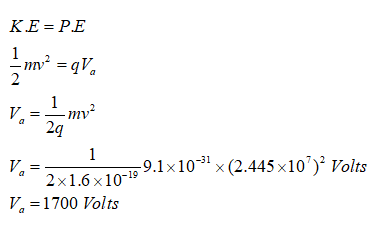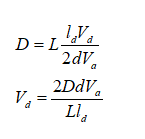Q1.) A CRT deflection plates of (60mm) long and (0.5cm) apart. The screen is (22cm away from the center of deflection plates. The electrons enter the plates with velocity o (2.445x10'm/sec). If an input signal is applied, it will produce (3cm) deflection on the scree with an angular deflection of (7.77°). Determine: 1- Acceleration voltage. 2- Deflection potential. 3- The coordinate of electrons beam at the center of deflection plates. 4- The time taken by electrons beam in its traveling from the end of deflection plates to th screen. Note: m= 9.1x10'kg e=1.6x10l°C
Q1.) A CRT deflection plates of (60mm) long and (0.5cm) apart. The screen is (22cm away from the center of deflection plates. The electrons enter the plates with velocity o (2.445x10'm/sec). If an input signal is applied, it will produce (3cm) deflection on the scree with an angular deflection of (7.77°). Determine: 1- Acceleration voltage. 2- Deflection potential. 3- The coordinate of electrons beam at the center of deflection plates. 4- The time taken by electrons beam in its traveling from the end of deflection plates to th screen. Note: m= 9.1x10'kg e=1.6x10l°C
Introductory Circuit Analysis (13th Edition)
13th Edition
ISBN:9780133923605
Author:Robert L. Boylestad
Publisher:Robert L. Boylestad
Chapter1: Introduction
Section: Chapter Questions
Problem 1P: Visit your local library (at school or home) and describe the extent to which it provides literature...
Related questions
Question

Transcribed Image Text:Q1.) A CRT deflection plates of (60mm) long and (0.5cm) apart. The screen is (22cm
away from the center of deflection plates. The electrons enter the plates with velocity o
(2.445x10'm/sec). If an input signal is applied, it will produce (3cm) deflection on the scree
with an angular deflection of (7.77°). Determine:
1- Acceleration voltage.
2- Deflection potential.
3- The coordinate of electrons beam at the center of deflection plates.
4- The time taken by electrons beam in its traveling from the end of deflection plates to th
screen.
Note:
m= 9.1x10'kg
e=1.6x10l°C
Expert Solution
Step 1
We are authorized to answer three subparts at a time since you have not mentioned which part you are looking for, so we are answering the first three subparts, please repost your question separately for the remaining subpart.
1-
At any moment, the kinetic energy of the electron will be equal to its potential energy. From the calculation, we can determine the acceleration voltage as shown below:

The acceleration voltage is 1700 Volts
Step 2
2-
The deflection potential is given by the expression as shown below:

Plugging the values in the above expression,

Step by step
Solved in 3 steps with 4 images

Recommended textbooks for you

Introductory Circuit Analysis (13th Edition)
Electrical Engineering
ISBN:
9780133923605
Author:
Robert L. Boylestad
Publisher:
PEARSON

Delmar's Standard Textbook Of Electricity
Electrical Engineering
ISBN:
9781337900348
Author:
Stephen L. Herman
Publisher:
Cengage Learning

Programmable Logic Controllers
Electrical Engineering
ISBN:
9780073373843
Author:
Frank D. Petruzella
Publisher:
McGraw-Hill Education

Introductory Circuit Analysis (13th Edition)
Electrical Engineering
ISBN:
9780133923605
Author:
Robert L. Boylestad
Publisher:
PEARSON

Delmar's Standard Textbook Of Electricity
Electrical Engineering
ISBN:
9781337900348
Author:
Stephen L. Herman
Publisher:
Cengage Learning

Programmable Logic Controllers
Electrical Engineering
ISBN:
9780073373843
Author:
Frank D. Petruzella
Publisher:
McGraw-Hill Education

Fundamentals of Electric Circuits
Electrical Engineering
ISBN:
9780078028229
Author:
Charles K Alexander, Matthew Sadiku
Publisher:
McGraw-Hill Education

Electric Circuits. (11th Edition)
Electrical Engineering
ISBN:
9780134746968
Author:
James W. Nilsson, Susan Riedel
Publisher:
PEARSON

Engineering Electromagnetics
Electrical Engineering
ISBN:
9780078028151
Author:
Hayt, William H. (william Hart), Jr, BUCK, John A.
Publisher:
Mcgraw-hill Education,